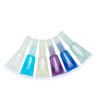Cranial neural crest recycle surface integrins in a substratum-dependent manner to promote rapid motility.
Strachan, LR; Condic, ML
The Journal of cell biology
167
545-54
2004
Show Abstract
Cell migration is essential for proper development of numerous structures derived from embryonic neural crest cells (NCCs). Although the migratory pathways of NCCs have been determined, the molecular mechanisms regulating NCC motility remain unclear. NCC migration is integrin dependent, and recent work has shown that surface expression levels of particular integrin alpha subunits are important determinants of NCC motility in vitro. Here, we provide evidence that rapid cranial NCC motility on laminin requires integrin recycling. NCCs showed both ligand- and receptor-specific integrin regulation in vitro. On laminin, NCCs accumulated internalized laminin but not fibronectin receptors over 20 min, whereas on fibronectin neither type of receptor accumulated internally beyond 2 min. Internalized laminin receptors colocalized with receptor recycling vesicles and were subsequently recycled back to the cell surface. Blocking receptor recycling with bafilomycin A inhibited NCC motility on laminin, indicating that substratum-dependent integrin recycling is essential for rapid cranial neural crest migration. | 15520227
 |
Developmentally regulated expression of alpha 6 integrin in avian embryos.
Bronner-Fraser, M, et al.
Development, 115: 197-211 (1992)
1992
Show Abstract
The distribution pattern of the avian alpha 6 integrin subunit was examined during early stages of development. The results show that this subunit is prevalent in cells of the developing nervous system and muscle. alpha 6 is first observed on neuroepithelial cells of the cranial neural plate and trunk neural tube. With time, immunoreactivity becomes prominent near the lumen and ventrolateral portions of the neural tube, co-distributing with neurons and axons, particularly notable on commissural neurons. The alpha 6 expression pattern is dynamic in the neural tube, with immunoreactivity peaking by embryonic day 6 (stage 30) and decreasing thereafter. The ventral roots and retina exhibit high levels of immunoreactivity throughout development. In the peripheral nervous system, alpha 6 immunoreactivity first appears on a subpopulation of sympathoadrenal cells around the dorsal aorta and later in the dorsal root ganglia shortly after gangliogenesis. Immunoreactivity appears on prospective myotomal cells as the somites delaminate into the dermomyotome and sclerotome, remaining prominent on myoblasts and differentiated muscle at all stages. The mesonephros also has intense immunoreactivity. In the periphery, alpha 6 immunoreactive regions often in proximity to laminin, which is thought to be the ligand of alpha 6 beta 1 integrin. | 1638980
 |
Expression and function of chicken integrin beta 1 subunit and its cytoplasmic domain mutants in mouse NIH 3T3 cells.
Hayashi, Y, et al.
J. Cell Biol., 110: 175-84 (1990)
1990
Show Abstract
Chicken integrin beta 1 cDNA and its site-directed mutants were cloned into a mammalian expression vector and introduced into mouse NIH 3T3 cells. Stable transfectants expressing the chicken beta 1 subunit or its site-directed mutants were identified by immunostaining with antibodies specific for the chicken integrin beta 1 subunit. The chicken beta 1 proteins were expressed predominately in the endoplasmic reticulum of transfectants and to a lesser degree in the plasma membrane. Immunoblots and immunoprecipitations, using anti-chicken integrin antibodies, revealed three different sizes of the chicken subunit (90, 95, and 120 kD) and a mouse 140-kD alpha subunit. Immunoprecipitations of the cell surface receptors showed only two peptides, an 120-kD beta 1 and an 140-kD alpha subunit. Antibodies perturbing mouse and chicken integrin-specific cell adhesions were used to demonstrate that the chimeric receptors functioned in adhesion to both laminin and fibronectin. Immunofluorescent staining with antibodies specific for either the chicken or mouse receptors showed that both the wild type and the chimeric receptors localized in focal contacts. Several mutations in the cytoplasmic domain were synthesized and used in the transfection experiments. In one mutant the tyrosine (Tyr 788) in the consensus sequence for phosphorylation was replaced by a phenylalanine. In another the lysine (Lys 757) at the end of the membrane spanning region was replaced by a leucine. Both of these mutants formed dimers with mouse alpha subunits, participated in adhesion, localized in focal contacts, and displayed biological properties indistinguishable from the wild-type transfection. In contrast, mutants containing deletions greater than 5-15 amino acids nearest the carboxyl end in the cytoplasmic domain neither promoted adhesion nor localized in focal contacts. They did, however, form heterodimers that were expressed on the cell surface. | 2104857
 |















